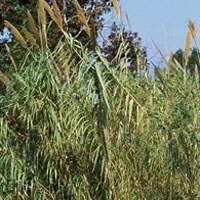Use of giant reed (Arundo donax L.) to control soil erosion and improve soil quality in a marginal degraded area

HTML: 22
All claims expressed in this article are solely those of the authors and do not necessarily represent those of their affiliated organizations, or those of the publisher, the editors and the reviewers. Any product that may be evaluated in this article or claim that may be made by its manufacturer is not guaranteed or endorsed by the publisher.
Soil erosion is one of the biggest environmental problems throughout European Union causing considerable soil losses. Vegetation cover provides an important soil protection against runoff and soil erosion. To this aim, unlike annual crops, perennial plants have the advantage of covering soil for a longer time and reducing soil erodibility thanks to SOM increase due to litter effect and to reduction of soil disturbance (no-tillage). Two experiments were carried out in marginal hilly areas (10% slope) of Southern Italy: i) long-term experiment in which it was evaluated the effect of two fertilization doses (N: 100 and 50 kg N ha−1 from urea) on Arundo donax L. biomass production as well as its effect on soil erosion; ii) three-year experiment to evaluate the soil cover capacity of the giant reed by analysing the plant leaf area index (LAI). Results of the two experiments showed a good soil protection of Arundo donax L. that reduced soil losses by 78% as compared to fallow and showed soil erosion reduction not different from permanent meadow thanks to the soil covering during the period with the highest rain erosivity and to the reduction in soil erodibility. The protective effect of Arundo donax L. from rain erosivity was also confirmed by LAI analysis that showed a good soil covering of giant reed in the above mentioned period, even during the initial yield increasing phase following crop transplant. According to biomass yield, from the fifteen year of cultivation in a low fertile inland hilly area of Southern Italy, giant reed was characterized by a yield-decreasing phase that resulted postponed as compared to more fertile environments thus ensuring a longstanding soil protection from soil erosion. In addition, the higher nitrogen fertilization dose (100 kg ha−1 of N) allowed interesting biomass yield as compared to the lower dose (50 kg N ha−1) and kept constant SOC along the year of experimentation due to an improved contribution of leaf fall, root exudates and root turnover to soil.
Highlights
- Soil erosion is an important environmental problem in Mediterranean hilly areas.
- Arundo donax L. can significantly reduce soil erosion in hilly cropland.
- Soil protection of giant reed is high during the months with higher rain erosivity.
- High N inputs enhance giant reed biomass production and soil fertility conservation.
- In hilly areas yields are lower but more stable over time than in more fertile environments.
How to Cite
PAGEPress has chosen to apply the Creative Commons Attribution NonCommercial 4.0 International License (CC BY-NC 4.0) to all manuscripts to be published.

 https://doi.org/10.4081/ija.2020.1764
https://doi.org/10.4081/ija.2020.1764



